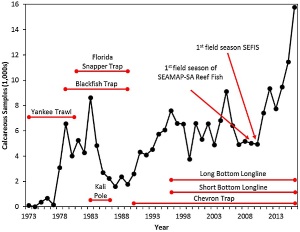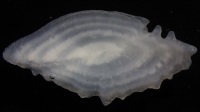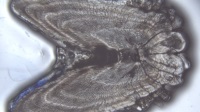Reef Fish Survey (RFS)
Marine Resources Monitoring, Assessment, and Prediction (MARMAP) &
Southeast Area Monitoring and Assessment Program South Atlantic (SEAMAP-SA)
Age and Growth Laboratory

The most commonly used structures by fisheries biologists to age fishes are otoliths and spines. Otoliths are a calcareous structure found in the inner ear of all bony fishes that aid with sensing gravity and hearing, whereas spines are a hard calcareous structure found in fish fins. Ageing fishes using otoliths and spines is a similar process to aging trees, as the fish grows it experiences seasonal changes in growth leading to increment formation on an annual basis, in a similar fashion to that of a tree ring formation. In order to count the increments, otoliths and spines are thinly sectioned and placed under a microscope, but for some species this is not necessary and we are able to read the otolith whole. Aging fish is part of the standard fishery-independent monitoring of South Atlantic reef fish done by the RFS every year.
RFS biologist extract otoliths and spines by dissection during research cruises and are then brought back to the lab for processing. While there are many methods to thinly section otoliths and spines, RFS biologists embed otoliths in epoxy resin or mount whole spines to a cutting plate with hot glue, section them on a saw, mount sections onto microscope slides, and examine slides using a microscope (called "reading"). Although this method can be more time consuming it provides the highest quality samples.
Currently, the RFS focuses on sample collection from 14 priority species, with other species (not listed) being retained in lower numbers:
- Black Sea Bass (Centropristis striata)
- Snowy Grouper (Hyporthodus niveatus)
- Scamp (Mycteroperca phenax)
- Gag (M. microlepis)
- Red Grouper (Epinephelus morio)
- Vermillion Snapper (Rhomboplites aurorubens)
- Red Snapper (Lutjanus campechanus)
- Golden Tilefish (Lopholatilus chamaeleonticeps)
- Blueline Tilefish (Caulolatilus microps)
- Red Porgy (Pagrus pagrus)
- Knobbed Porgy (Calamus nodosus)
- Gray Triggerfish (Balistes capriscus)
- Greater Amberjack (Seriola dumerili)
- White Grunt (Haemulon plumierii)
Age data (along with various other data) that is collected by RFS biologists is supplied to stock assessments, where fisheries managers can use the information to determine the health of a fish population and make important management decisions to ensure sustainability of the fishery.


